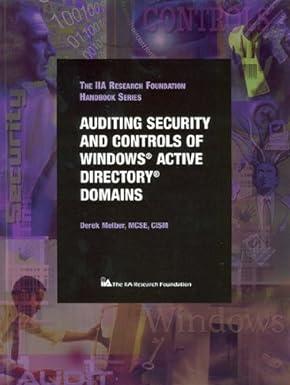Question
Accounting for cryptocurrency holdings BVV Co. (the Company) supports and sells computer software. When the company sells a copy of its software, they not only
Accounting for cryptocurrency holdings
BVV Co. (the Company) supports and sells computer software. When the company sells a copy of its software, they not only accept payments in cash or using credit cards, but also accepts cryptocurrencies such as Bitcoin, Ethereum, Ripple or Omni as payment for the sale. The Company holds its cryptocurrencies partially for investment (e.g., expectation that they will appreciate in value) and partially to pay for goods and services they purchase from other entities in the future.
Cryptocurrency is a new type of value and payment method that is different from fiat currency (e.g., U.S. dollars and foreign currencies). Currently, cryptocurrencies have neither government backing nor recognition by a central authority as legal tender. Their value is only supported by the market supply and demand.
Cryptocurrencies do not have a physical form but exist as immutable distributed ledgers (electronic records) maintained on public blockchains. They are different than electronic instances of cash, such as an online bank account, in that they are not linked to a physical currency.
Altcoins, such as Bitcoin and other similar coins, use cryptography (e.g., use of codes to secure communications) to control the security and creation of these coins, which led to the term cryptocurrencies.
There are other crypto-assets that are not cryptocurrencies, such as tokens (e.g. Bitcoin cash). It is important to distinguish between different types of cryptocurrencies.
| Altcoin is a unit of value that is native to a blockchain. It is a means of exchange within the blockchain to incentivize the network of participants to use the blockchain. The sole purpose of a cryptocurrency is for exchange of value, and it has limited functionality beyond that. A token is a piece of business logic (i.e., smart contract) coded into an existing blockchain. A token can have a functionality beyond an exchange of value it can represent any asset or functionality desired by the developer for use on a platform. Tokens may be an interest in an entity (e.g., security token), an interest in a specific asset (asset token), or a right to a future product or service (utility token).
|
Altcoins can be received directly from a counterparty in exchange for an asset or service or they can be purchased in exchange for a fiat currency, often from an exchange that specializes in cryptocurrencies. Altcoins are usually obtained by purchasing or receiving them on a peer-to-peer basis.
Every altcoin each possess their own independent blockchain. For a cryptocurrency to function as a means of peer-to-peer exchange, a ledger needs to be maintained for tracking ownership of the cryptocurrency. For altcoins, this electronic ledger is maintained using blockchain. There are many copies of this ledger and many ledger keepers. Distributing the processing allows many users to each play a small part in the maintenance of the ledger system; this means that the security of the system does not rely on a few individuals.
The amount of coins for a particular cryptocurrency that are in circulation is tightly controlled. For example, for Bitcoin there is a limit on the number of coins that can exist. New Bitcoins are only created as payment to processors (called miners) for providing the service of validating and distributing an electronic ledger of transactions to those involved in maintaining the blockchain. Technically, anyone can mine a coin. Miners are tasked with solving a computational process to confirm that a peer-to-peer transaction is legitimate. Once solved, the transaction is awarded with a confirmation on the blockchain, and the miner is credited with a transaction fee.
Questions:
1. How should the Companys holdings of cryptocurrency be classified in the statement of financial position under U.S. GAAP and IFRS Standards?
2. How should the holdings of cryptocurrency be initially and subsequently measured under U.S. GAAP and IFRS Standards?
Step by Step Solution
There are 3 Steps involved in it
Step: 1

Get Instant Access to Expert-Tailored Solutions
See step-by-step solutions with expert insights and AI powered tools for academic success
Step: 2

Step: 3

Ace Your Homework with AI
Get the answers you need in no time with our AI-driven, step-by-step assistance
Get Started


